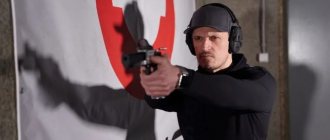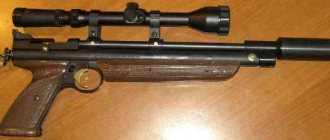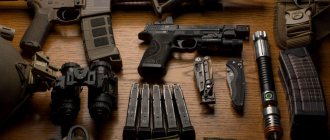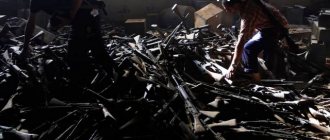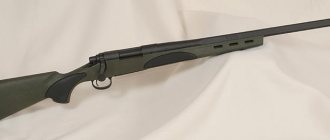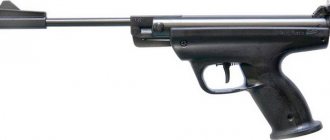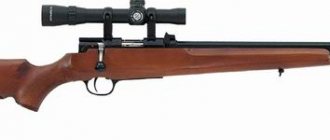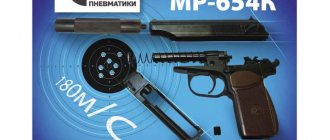Spring-piston air guns
This section of our Popadiv10 website presents spring-piston type pneumatic pistols.
The energy for firing a shot is the air generated during the expansion of a twisted or gas spring. This type of pneumatics is not as widespread as gas-cylinder ones, but also has a large army of amateurs. Our online store offers the following brands:
- Baikal (Russia);
- Gamo (Spain);
- Blow (Türkiye);
- Hatsan (Türkiye);
- Crosman (USA);
- Umarex (Germany);
- Strike One (China).
In comparison with gas-cylinder or multi-compression pneumatics, spring-piston weapons do not show serious power. However, it is distinguished by ease of use, the presence of durable mechanisms and purchase without a special license.
The manufacturer of each type of air gun takes operational safety seriously. For these purposes, each model is equipped with a special fuse. With its help, it is impossible to make an accidental shot.
Spring-piston air pistols are better suited for recreational shooting. Of course, some shooters manage to shoot a rodent or bird.
The rifle brother of the Tulyak pistol is OF-93
A pioneer in the field of special weapons. The KS-23 carbine (23 mm) became the intended purpose. Taking into account many of its characteristics, the designers decided to create the OF-93 farm shotgun, which would be intended for civilian use. It was distinguished by maximum ease of use, low price and cheap production. However, it was produced in limited quantities, since the civilian market was not able to discern the full potential of this gun, although it had many unique features. And only then, after the practical use of OF-93, a special pistol “Tulyak” was created for special forces and police.
Created in 1993, the farmer's gun was reminiscent of many Liberty pistols of World War II in its ascetic appearance. It was this asceticism, that is, simplicity, that was the main feature of the weapon. On the other hand, it is important to note another highlight of it – modularity. What it is?
In fact, the OF-93 can be used in two versions: as a rocket launcher and as a shotgun. Surprisingly, the designers easily combined these two disparate possibilities. The secret lies in the barrel of the weapon. The OF-93 itself has a short 4-caliber barrel (just for signal flares). However, you can screw a 12-gauge barrel into this barrel, thereby using a completely different cartridge - 23 mm.
OF-93 in a collapsible state (you can also unscrew the stock)
It’s curious, but when the weapon first went on sale, it was also possible to purchase special 4-caliber rubber bullets. However, taking into account Russian legislation, these ammunition disappeared from the shelves as quickly as they appeared. And all because with the use of such traumatic rubber bullets, any OF-93 could be used as a short-barreled self-defense weapon, which is prohibited by law.
Instead of the usual safety, the firing mechanism had a special button on the left side of the OF-93, without pressing which it was impossible to fire a shot. The creators of the gun borrowed this design solution from the German Heckler & Koch P7 pistol. The gun is single-shot; to reload, you need to break the OF-93 in half, remove the spent cartridge case and insert a new cartridge. The length of the unscrewed barrel is 40 cm, and the package includes a non-folding stock. The total length of the weapon with the butt and 23 mm barrel is 80 cm. The total weight of the product is 2 kg.
OF-93 with forearm and butt
Key features of spring-piston air pistols:
- Muzzle energy does not exceed 7.5 joules;
- Shooting is carried out in single mode;
- Reloading is carried out by breaking the barrel or using an under-barrel lever;
- The initial speed of the ammunition reaches 130 meters per second;
- No special permission will be required;
- Classic lead bullets of 4.5 mm caliber;
- Easy to operate;
- Standard sights;
- Special rail for additional equipment.
Pistols are like rifles
Pistols with a longitudinally sliding rotary bolt or, respectively, with a tilting barrel were initially used in the USA for hunting, but over time they began to be used in shooting at silhouette targets. As a rule, shooting is carried out with rifle cartridges. To find out how accurate this weapon is, the editors of the German publication DWJ tested several typical samples.
In the 1960s, a new type of weapon began to conquer the American markets. Pistols have become in demand for long-range shooting, which is typical for hunting. These pistols were supposed to be on par with hunting rifles in their shooting efficiency. The real boom in this field began in the 1970s, thanks to silhouette shooting, which required accurate shooting pistols chambered for centerfire, capable of hitting targets at a distance of up to 200 m.
Hunting with short-barreled weapons and shooting silhouettes became possible due to further developments in the market segment of single- and multi-shot pistols chambered for centerfire cartridges. Work towards increasing the power of the caliber, as well as the desired increase in accuracy - the same as that of a shotgun - very soon led to the use of a longitudinally sliding rotary bolt. Progenitor
One of the important milestones was in 1963, when the XP-100 from Remington was born, whose bolt group was also repeatedly used in special pistols for shooting silhouettes. Unfortunately, Remington discontinued the XP-100 a few years ago. Remington produced the XP-100 in .221 Fireball, which was a shortened .223 Remington with a 10 1/2" (267 mm) barrel. Notable is its plastic stock with a handle located under the bolt, which required moving the trigger mechanism forward. The single-shot locking system is borrowed from the Remington Model 600, introduced around the same time. With the emergence of this new type of hunting pistol based on a conventional rotary sliding bolt, other extraordinary designs of the pistol simultaneously appeared.
Introduced in 1963, the Remington XP-100 chambered in .221 Fireball can be considered the progenitor of all modern bolt-action pistols. Unfortunately it is no longer produced.
For example, the original version of the XP-100 had a plastic stock that was revolutionary at the time. In 1959, Remington surprised the gun world with the Nylon 66 small-bore shotgun. Apart from the barrel, locking assembly and a number of small parts, the Nylon 66 model was made entirely of plastic. Nylon 66 stock material was used in the XP-100 released four years later. During these years, the arms company belonged to the chemical concern DuPont, which developed a polymer material called Zytel specifically for rifle stocks, which was used in stocks of the Remington Nylon 66 and XP-100 models.
Very quickly, custom gunsmiths mastered the XP-100 bolt group. Options have appeared in powerful calibers and with extended barrels. Long eye relief scopes became even more common, so XP-100 based systems made even more sense. Piece versions based on the XP-100 have become especially popular among silhouette shooters. Remington responded with new hunting calibers, with the barrel length increasing to 141/2'' (368 mm). In 1980, silhouette shooters received a specially designed 7 mm BR Remington cartridge, intended for match disciplines and mass-produced.
The .221 Fireball cartridge is a shortened .222 Remington cartridge and is primarily chambered in advanced rifle powders.
Pistols of ever more powerful calibers constantly appeared. For example, from 1986 until production ended in 1994, the .223 Remington caliber was offered. Also available were .22-250 Remington, .250 Savage, 6 mm BR Remington, 7 mm-08 Remington, .308 Winchester and .35 Remington. The Remington Custom Shop has produced a number of special edition XP-100 models. All of these models were single-shot. From 1991 to 1994 and again in 1998, there was also a magazine version in which the handle had to be moved back to accommodate the magazine in the plastic forend. The palette of calibers used for the magazine version (1991–1994) covered calibers .223 Remington, .250 Savage, 7 mm-08 Remington, .308 Winchester, .35 Remington and .350 Remington Magnum. In 1998, the .223 Remington, .22–250 Remington, .260 Remington and .35 Remington were introduced.
The 7 mm BR Remington was originally manufactured from .308 Winchester sized cases.
The additional designations Varmint Special, Hunter and Silhouette indicated the different purposes of the pistols. In addition to plastic stocks, there were also versions with a wooden stock. Easy barrel change
An alternative to the Remington XP-100 was initially the Contender from Thompson/Center. The Contender is a flip-barrel, exposed-cock pistol with a very easy-to-use interchangeable barrel system. Interchangeable barrels of various lengths and numerous calibers are available. The caliber range extends from the popular .22 lr sidefire cartridge, all the way to the popular pistol, revolver and mid-power rifle cartridges. They are complemented by replacement barrels of rare calibers manufactured for the Contender by third parties. Several years ago, production of second-generation pistols began under the designation Contender G2. Another modification is the Encore family. Weatherby's tumultuous history
Weatherby became interested in the "silhouette" pistol in the late 1970s. Roy Weatherby's friend Elgin Gates, the "generator" who gave impetus to the silhouette shooter movement, spearheaded this development. Based on the Mark V Varmintmaster bolt group, a silhouette pistol emerged, which today is a true rarity among Weatherby weapons. Until 1981, only 200 copies of this pistol were produced - 150 in .308 Winchester caliber and 50 in .22-250 Remington caliber. For these pistols, the trigger was moved forward to place the handle under the bolt group. The small circulation of this Weatherby pistol is explained by the Japanese government's ban on the export of short-barreled weapons. Weatherby weapons at that time were produced in Japan by Howa. Introduced in the late 1990s after production moved to the United States, the Centerfire Pistol in its original form was intended more for hunting than silhouette shooting and was available in .22–250 Remington, .243 Winchester, 7 mm calibers. -08 Remington and .308 Winchester.
Only a few years later, Weatherby launched another bolt-action pistol model as a new product in 2006. This Weatherby model features a plastic stock. The main feature of the new repeating pistol is the Mark V action chambered in a standard cartridge, which was designed by Weatherby in 1998/99. It is related in its fundamental design to the full-size Mark V bolt group, but is aimed at standard cartridges, such as, for example, the .30-06 Springfield. The company then launched on the market, together with the new, smaller Mark V bolt group, a whole range of medium-caliber carbines.
The most important feature of the Mark V bolt group is the locking of nine lugs located at the head of the bolt. They are arranged in three rows with three stops in each. The bolt mirror is recessed relative to the front end of the bolt, so the bottom of the cartridge is surrounded on all sides.
In addition to the enlarged Mark V bolt group for the small, now discontinued .224 Weatherby cartridge, there was a Mark V Varmintmaster bolt group whose magazine size allowed the use of cartridges with a maximum length of 64 mm. Available in .224 Weatherby and .22-50 Remington. Instead of nine lugs, the Mark V Varmintmaster bolt group was equipped with only six lugs.
Introduced in 1998/99, the Mark V Ultra Lightweight action for standard .30-06 Springfield cartridges is, in terms of overall dimensions, a cross between the larger Mark V action and the smaller Varmintmaster.
The structurally reduced Mark V bolt group for standard cartridges differs from its older brother only in overall dimensions, as well as in the number of lugs. Instead of the nine lugs on the Mark V bolt group, the 28% lighter standard group has only six lugs arranged in three rows of each other, with two lugs in each row. The CFP repeating pistol is based on this group.
The Weatherby CFP (Compact Firing Plattform) is a repeating weapon. The weapon tested was chambered for the .22-250 Remington cartridge.
With short cartridges used in the CFP pistol, the magazine is filled from the rear using a metal angle and the bolt travel is made accordingly. This ensures that the bolt is not pulled back further than the magazine window allows. With a barrel length of 16 inches (406 mm), the overall length of the Weatherby CFP is 699 mm, so it is a long-barreled weapon under German gun law and is not subject to the ban on short-barreled repeaters chambered for centerfire cartridges with a caliber of less than 6.3 mm (1.2 .5, appendix 2, section 1 of the Weapons Law). Thus, versions chambered for .224 caliber cartridges are available for purchase in Germany.
The CFP receiver is flat on the bottom. Under the breech there is a plate that absorbs recoil.
Numerous custom models
Numerous small gun manufacturers also produced single-shot bolt-action pistols. Depending on their purpose, these pistols were equipped with an optical sight for hunters, and for silhouette shooters with special open sights. The Wichita pistol became the most famous in the USA. In Germany, Keppeler offered specialty weapons during the heyday of silhouette shooting. Today, only a small percentage of shooters practice silhouette shooting.
Impressive efficiency
If hunters choose a caliber depending on the object of the hunt, then for silhouette shooters the energy of the cartridges used should be sufficient to overturn a steel silhouette target. As a compromise between the necessary ballistic characteristics and acceptable recoil, short 7 mm cartridges have gained recognition. These include the 7 mm TCU cartridge based on the .223 Remington case, introduced in 1980 by Thompson/Center for the Contender pistol. In Europe, the Swiss Guido Wasser was distributing his 7x49 GJW ammunition, based on the 5.6x50 Magnum cartridge case. This group of 7 mm cartridges also includes the 7 mm BR Remington, which was first made from a special case in .308 Winchester dimensions and was adapted for small rifle primers. The most powerful cartridges for silhouette shooting competitions are the .308 Winchester caliber.
Loss of power and accuracy
When using pistols, which from the point of view of their design are shortened rifles, two questions are primarily of interest. The first of these concerns the loss of power in rifle calibers due to a shorter barrel, and the second is the issue of shooting accuracy. The first question depends, of course, on the length of the barrel and the geometry of the cartridge case, as well as on the volume of the cartridge case. In the 16-inch (406 mm) barrel of our Weatherby CFP in .22–50 Remington, the loss of muzzle velocity compared to a 600 mm rifle barrel, depending on loading conditions, was between 15 and 20% V0. In the .221 Fireball, the V0 loss from a 10 1/2" XP-100 barrel compared to a 22" barrel with a 40 grain (2.6 g) bullet ranged from 100 to 150 m/s.
The Weatherby CFP rotating bolt has six lugs arranged in two rows.
The author explored the topic of shooting accuracy with the XP-100 series pistols, as well as with custom versions based on the XP-100 (all of which are single-shot), Weatherby CFP in .22-250 Remington caliber and Contender pistols. For high-precision shooting, all tested models were equipped with a Leupold scope with a long eye relief. 4×32 EER and 2.5–8×32 EER versions were used. The author shot from a distance of 100 m while sitting from a rest position. An adjustable benchrest machine served as the front stop. The pistol grip rested on a flat sandbag. All dispersion diameters were obtained from groups of five shots. The tightest group was obtained with a .221 Fireball loaded with Hornady's 50-grain V-Max bullet. The dispersion diameter with this equipment option was 27 mm. Our test weapon in .223 Remington with a 52-grain (3.4 g) Sierra Matchking bullet produced a dispersion diameter of 23 mm. Weatherby's CFP in .22-250 Remington produced dispersion diameters ranging from 28 to 32 mm. With the Contender 7mm TCU, the tightest group obtained with the 130 grain (8.4 g) Sierra bullet was 34 mm. In 7 mm BR Remington it produced a dispersion diameter of 25 mm with a Sierra SP bullet weighing 120 grains (7.8 g). In 7 mm-08 Remington, the recoil becomes noticeably stronger. With Hornady's 154 grain (10 g) SST bullet, dispersion diameters of 29 to 30 mm were achieved. Comparable accuracy was shown by the .308 Winchester with a Sierra Mathcking bullet weighing 168 grains (10.9 g). The .30-30 Winchester rounds fired from a Contender with a 14-inch barrel produced groups between 35 and 41 mm with the 150-grain Sierra SP-FN bullet. All equipment options given in the review ensured that the DSB target (50 mm) hit the top ten at 100 m. Since we are talking about single-shot models, in some equipment options the L6 value (total length of the cartridge) with extended pointed bullets may be exceeded, as far as the bullet entry allows. In some cases, those who load cartridges themselves must select the conditions for loading the ammunition here. This problem is typical for the .30-30 Winchester, which is loaded with blunt-point bullets for Henry-buckle reloading weapons. For the pointed bullets that can be used in the Contender pistol, the L6 value is exceeded in all cases.
Thompson/Center's Contender, here with a 14-inch barrel, has an easy barrel change system.
DWJ findings
The ancestors of modern hunting pistols are the Remington XP-100 bolt-action pistol, introduced in 1963, and the T/C Contender, a flip-barrel pistol introduced in 1967, equipped with a simple barrel replacement system. Both weapon systems very soon began to be used for silhouette shooting (in Germany under the auspices of BDS). Very often, discussions arise in close circles about the possible accuracy of shooting from such pistols. We tried shooting some of these classic models at a rifle range of 100 m. The results amazed some eyewitnesses. In the best cartridge-weapon combinations, it was possible to achieve groups of just under 1 MOA (28 mm) - a result that is on par with a conventional hunting repeating rifle. Hans J. Heigel Translation by Ilya Shaidurov
Functional features of spring-piston pneumatic pistols
Every shooting enthusiast undoubtedly expects serious performance from a weapon, not only in speed, but also in functionality and the ability to equip it with additional devices.
In a particular case, spring-piston pneumatics will allow you to easily install tactical devices due to the presence of a special Weaver-type rail. In some modifications, the bar is located at the bottom of the barrel.
The owner of a spring-piston pistol will be the proud owner of a laser target designator and a tactical flashlight. This will increase the likelihood of accurately hitting the target in complete darkness.
Of course, this could not have happened without standard devices. These include a front sight, a rear sight and, in some models, a sighting bar with height adjustment.
After several training sessions, the owner of the pneumatic gun will easily hit the target from close and medium distances.
By the way, the best aiming distance is 30 meters. At this distance, provided there is no headwind, the target will be hit right on the bull's eye.
And although most modifications are manufactured far beyond Russia, the price of spring-piston pneumatic pistols will pleasantly surprise every buyer.
general information
The models differ from each other not only in appearance, but also in the type of trigger mechanism. Previously, single-shot air pistols with compressed air cartridges were used.
But due to their high cost, as well as complex reloading, they were eventually replaced by simple models with a breaking barrel for manual loading.
They are fired using a compressed spring, which at the moment of release moves the cylinder at high speed. Due to the movement of the latter, high pressure is created in the barrel.
It is important to note that the use of single-shot pistols with cartridges is not entirely safe, since the air in the containers is stored at a pressure of about 30-35 atmospheres. If the charging algorithm is violated, the cylinders may explode.
Very interesting material about the weight of the PSS pistol with an empty magazine.
Design features of spring-piston pistols
The main design feature is the presence of a fracture trunk. The design is the same principle of operation as in air rifles.
Even a teenager can break a gun barrel, since no serious effort is required. Despite its simplicity, the design is highly durable.
For this, first of all, we should thank the engineers who used proven weapons-grade metal in the manufacture of the case. To protect against possible rust, all steel parts are coated with a special solution.
Therefore, even after 10 years, the pistol body will remain in perfect condition, attracting admiring glances.
The auxiliary materials are impact-resistant plastic and natural wood. The main difference between plastic and wood is its low weight. In addition, the polymer is resistant to moisture and mechanical damage.
Elements made of natural wood are coated with durable varnish, which prevents drying out.
Types of pistol ammunition
If we consider live ammunition, they mainly differ in caliber, that is, the diameter of the bullet, which corresponds to the internal diameter of the barrel. For pistols, the cartridges used are small; the cartridges are generally compact and quite lightweight.
Common options in the world are as follows:
- 5.45x18 for PMZ;
- 7.62x25 for TT;
- 9 mm cartridges can have a length of 17, 18, 19, 21, 22, 23, 29, 32 mm - with increasing length, the powder charge also increases, increasing the power of the shot;
- 10 mm can have a length of 22 and 25 mm;
- for revolvers use 10.4x33; 10.18x33; 11.43x23; 11.43x33.
Cartridges 9x18 mm
For pneumatics, the choice of bullets is even wider; they do not have a powder charge. These are either tips with a seal or steel balls. The configuration of the former can be very different - from spherical or conical to stepped or with a recess.
Ruger Super Redhawk
The Super Redhawk is an American double action revolver designed with the hunter in mind. These pistols have all stainless steel construction and come with machined scope bases and optic mounting rings. The Super Redhawk's massive frame uses a lot of steel, making these guns extremely strong and durable. It also adds weight to the pistol's frame, which isn't a bad thing considering the Super Redhawk carries hot cartridges like the .454 Casull and .480 Ruger, in addition to the venerable .44 Magnum. The triple locking cylinder enhances the Super Redhawk's reputation for rugged reliability. Expect these double-action revolvers to last for decades, even when firing heavy magnum ammunition. All Super Redhawks come with precision cold hammer-forged Ruger barrels for maximum accuracy. Hogue Tamer grips mitigate the effects of heavy recoil. MSRP: $1,159 - $1,189
Read more:
Why the 10mm Pistol Cartridge is Ideal for Hunting and Personal Defense
Smith & Wesson Performance Center Model 629 .44 Magnum Hunter
The Smith & Wesson N-Frame Model 29 and 629 .44 Magnum revolvers have been popular among hunters for many years because these guns offer outstanding reliability and accuracy in a popular large caliber that most shooters can handle. Last year I carried a Performance Center Model 629 .44 Magnum Hunter in Nebraska and shot a deer at 50 yards and a deer at 65 yards with the gun. Both Hornady bullets hit exactly where they were supposed to, and both deer died within 20 yards. A muzzle brake and large molded rubber grip help reduce recoil, and a top rail makes mounting optics quick and easy. MSRP: $1,398
Taurus Raging Hunter
Raging Hunter revolvers are available in .357 Magnum, .44 Magnum and .454 Casull. and three barrel lengths: 5.12, 6.75 and 8.37 inches. These double action wheel shotguns have a top rail for mounting optics. Barrel ports and a large padded grip help control recoil. Raging Hunter revolvers are available in either matte black or two-tone finishes, and feature a double-lock cylinder for years of reliable operation. These features along with a very reasonable price make the Raging Hunter a great option. MSRP: $928-$938
Smith & Wesson X-Frame revolvers
Smith & Wesson X-Frame revolvers are not for the faint of heart. heart, and they are probably not the best hunting pistol for new shooters. These massive revolvers are chambered for cartridges. 460 S&W Magnum or .500 S&W Magnum, both of which produce energy comparable to centerfire rifles. As you can imagine, the performance is excellent, and if you are a serious handgun hunter looking to hit elk, elk, bison, and large bears, these guns are a great choice. Just know that the X-Frame has amazing muzzle blast. But if killing a big bull or boar with a pistol is on your bucket list, these revolvers are your best bet. MSRP: $1,319 - $1,799
New Ruger Super Blackhawk
Bill Ruger's revolutionary single-shot Blackhawk was released in 1955 and a year later it was available in 44 Magnum. A modern take on the classic single-action revolver, modern Super Blackhawk revolvers feature machined sight bases, stainless steel construction, and your choice of a traditional grip contour or a Beasley grip. The Blackhawk's action is extremely reliable and accuracy is very good. MSRP: $959
Korth NXR .44 Magnum
The German company Korth Firearms makes perhaps the best revolvers in the world, and Ni Ghthawk Custom imports these weapons to the United States. The NXR .44 Magnum is available with a 4- or 6-inch hammer-forged 416R stainless steel barrel with a vented barrel shroud. The metalwork has a durable DLC coating, and the oversized Turkish walnut grip provides a secure grip on the pistol, even when shooting hot .44 Mag rounds. Other features include a top Picatinny rail and optional bottom rail for securing barrel weights, removable side panels and front sights, and adjustable rear sights. Korth revolvers are precision machines with incredible accuracy and a price to match. MSRP: $5,299
